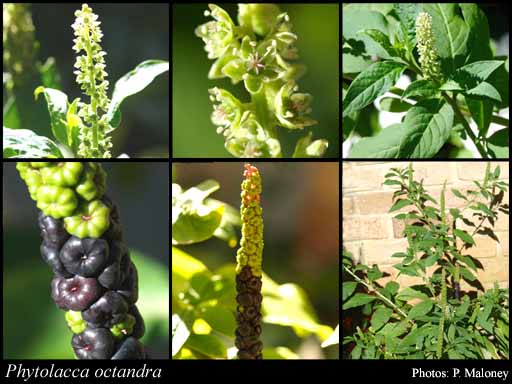- Reference
- Sp.Pl. [Linnaeus] edn 2, 1:631 (1762)
- Conservation Code
- Not threatened
- Naturalised Status
- Alien to Western Australia
- Name Status
- Current
Spreading, erect perennial, herb or shrub, 0.4-1.7 m high. Fl. white-pink-red, Jan to Mar or Sep or Dec. Sand, sandy loam. A weed of disturbed soils.

Distribution
- IBRA Regions
- Avon Wheatbelt, Coolgardie, Esperance Plains, Jarrah Forest, Swan Coastal Plain, Warren.
- IBRA Subregions
- Fitzgerald, Merredin, Perth, Southern Cross, Southern Jarrah Forest, Warren.
- IMCRA Regions
- Central West Coast, Leeuwin-Naturaliste, WA South Coast.
- Local Government Areas (LGAs)
- Albany, Cambridge, Capel, Cockburn, Collie, Dardanup, Denmark, Harvey, Joondalup, Kwinana, Mandurah, Melville, Mukinbudin, Perth, Plantagenet, Rockingham, South Perth, Stirling, Swan, Wanneroo, Waroona, Yilgarn.
Management Notes (for the Swan NRM Region)
Alternative Names. Pokeweed, Red Ink Plant, Tropical Pokeweed, Button Pokeweed.
General Biology. Growth form. Herb. Life form. Perennial. Reproduction. Seed. Dispersal. Birds, foxes (by ingestion). Seedbank persistence. Short, days- 1 year.
Notes. Generally appears after disturbance, such as clearing or fire. Aggressive growth can suppress any other plants growing beneath it. Develops a large woody taproot.
Additional information. Origin. North and South America.
Suggested method of management and control. Hand pulling is ineffective if the root is not removed and allowed to re-grow. Dig out isolated plants and cut root at least 5 cm below ground level. Otherwise spray with 1% glyphosate + Pulse®. Read the manufacturers' labels and material safety data sheets before using herbicides. For further information consult the Australian Pesticides and Veterinary Medicines Authority to determine the status of permits for your situation or state.
Management Calendar
| Calendar Type | Jan | Feb | Mar | Apr | May | Jun | Jul | Aug | Sep | Oct | Nov | Dec | Comments |
|---|---|---|---|---|---|---|---|---|---|---|---|---|---|
| Germination | U | U | U | ||||||||||
| Active Growth | Y | Y | U | U | U | U | U | U | U | Y | Y | Y | |
| Flowering | Y | Y | Y | ||||||||||
| Fruiting | Y | Y | |||||||||||
| Manual Removal | Y | Y | Y | Y | Y | Y | Y | Y | Y | Y | Y | Y | |
| Herbicide Treatment | U | U | U | U | U | U | Y | Y | Y |
Legend: Y = Yes, regularly, O = Occasionally, U = Uncertain, referred by others but not confirmed.
References
- Brown, K. & Brooks, K. (2002) Bushland Weeds: A Practical Guide to their Management. Environmental Weeds Action Network, Greenwood.
- Fergusona, R.N. & Drakea, D.R. (1999) Influence of vegetation structure on spatial patterns of seed deposition by birds. New Zealand Journal of Botany, 37 (4): 671 - 677.
- Hussey, B.M.J., Keighery, G.J., Dodd, J., Lloyd, S.G. & Cousens, R.D. (2007) Western Weeds. A guide to the weeds of Western Australia. 2nd Edition. The Plant Protection Society of Western Australia, Victoria Park.
- Moore, C.B. & Moore, J.H. (2002) Herbiguide, the pesticide expert on a disk. Herbiguide, PO Box 44 Albany, Western Australia, 6330.
- Swarbrick, J.T. & Skarratt, D.B. (1994) The bushweed 2 database of environmental weeds in Australia. The University of Queensland, Gatton College.
- USDA, ARS, National Genetic Resources Program (2009) Germplasm Resources Information Network - (GRIN). National Germplasm Resources Laboratory, Beltsville, Maryland. URL: https://npgsweb.ars-grin.gov/gringlobal/taxon/taxonomysimple.aspx - Accessed October 2009.